| The Early years |
| |
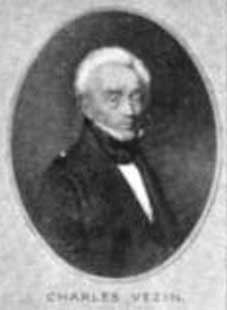 |
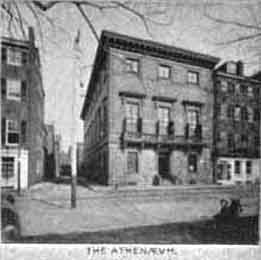 |
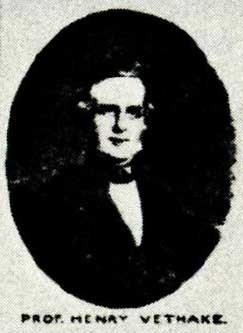 |
|
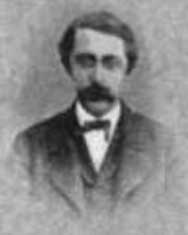
Philip P. Randolph
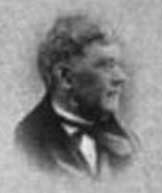
Prof. George Allen
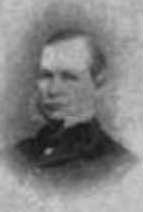
Dr. Samuel Lewis |
Chess in Philadelphia.
This is the title of a book on Quaker City Chess
now in press in Philadelphia. It is compiled and edited by Messrs. G. C.
Reichhelm and W. P. Shipley, and is a complete history of the game in that
locality from the early part of the century to the present day.
Philadelphia, more than any other city in the land, has encouraged the
cultivation of the game, and the many matches, tournaments and other similar
events in connection with the game are carefully recorded and amply
illustrated in the book. Only five hundred copies will be struck off, of
which already two hundred and fifty have been subscribed for. Those desiring
to possess a copy should, therefore, without further delay, send their
subscription to Mr. W. P. Shipley, Girard Building, Philadelphia. The price
of book is $2.50 per copy.
In this issue we present one of the many illustrations which will adorn
the book. It comprises the group of the earlier Philadelphia Chess Masters,
and together with this will be found a brief account of these players and a
beautiful illustrative gambit of the period.
The classic chess ground of Philadelphia—we might almost say America—was
the Philadelphia Athenaeum. There a distinctive school of the game was
cultivated which has no parallel outside of the seven stars of Berlin in the
decade from 1835 to 1845. Mr. Charles Vezin was the father and founder of
the Philadelphia coterie, and under his wing such brilliant pupils as Henry
Vethake, Benjamin Tilghman, Philip P. Randolph, Lewis Elkin, William G.
Thomas, Samuel Lewis and H. P. Montgomery grew into sturdy mastership. Mr.
Vezin, when in his prime in 1845, was almost the peer of Charles H. Stanley,
then chess champion of the United States. In their match played in that year
the score stood Vezin 7, Stanley 11, drawn 3. In the succeeding year Mr.
Vezin had the satisfaction of winning a correspondence game from Mr.
Stanley. After the death of the master in 1853, his pupils upheld the high
reputation of the Athenaeum School. In two matches against New York they won
each time, with scores of two to nothing, and in one to a draw, and these
famous parties still stand as models of correct play in the openings that
they illustrate. We should add that as early as 1847, Messrs. Randolph and
Tilghman won a similar match from the Boston Chess Club with the score of
one to a draw. Besides the more serious encounters, innumerable off-hand
games were contested, and these were chiefly in the domain of gambit play,
and as one of the bright particular games that have come down to us from
this past age, we re- publish a splendid Oliver gambit won by Philip P.
Randolph from Charles Vezin in 1847.
from the American Chess Monthly, 1897 |
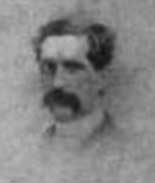
Hardman Philips Montgomery
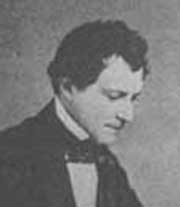
Lewis Elkin
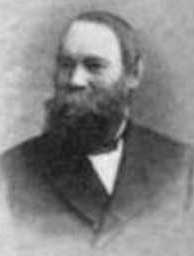
B. C. Tilghman |
|
The Athenaeum
as described in Notices of
Public Libraries in the United States of America
Printed for the House of Representatives , 1851, by Charles Coffin
Jewett
The whole
structure is 50 feet fronton Sixth street, 125 feet on Adelphi street, and
58 feet high. It is an excellent specimen of the Italian style of
architecture, treated with spirit and taste. The first story is divided into
offices, and a large room of 37 by C0 feet, 14 feet high, for the
comptrollers of the public schools. The second story is arranged for the
uses of the Athenaeum, and is divided into a news-room, library, and chess
room. The news-room is on the Sixth street front, and-is 37 by 47 feet, and
24 feel high; it will be finished in pilasters, with an enriched cornice and
cone to the ceiling. The library is 37 feet wide, 65 feet long, and 24 feet
high, and will be finished with a columnar ordinance of the Corinthian
order, advanced from the sides of the room, forming a centre cell or nave
and aisles; the latter will be filled up with bookcases, set laterally from
the pillars to the wall, and is designed at some future time to be finished
with a gallery, as the library extends; the cornice will be enriched with
modillions and ornament, the ceiling being in panel. The chess room is 18
feet square, and is an ante room between the two large rooms; a room of the
same size over this is intended for the directors' room. The third story is
divided into 8 rooms (three of large size;) one of them, to be occupied by
the Historical Society, is 26 feet by 37 feet, and 14 feet high.
A feature (says Mr. Wharton) of this institution, to which I would
advert with complacency, but certainly without boasting, is the free
admission which it has always afforded to strangers; meaning by this term,
persons not permanently residing in the city, or within ten miles of it,
introduced by members. It may be worthy of remark and remembrance, that,
according to a register kept by our worthy and attentive librarian, more
than 30,000 strangers have visited the rooms and availed themselves of the
facilities and conveniences which they afford. During certain years the
number has exceeded 1,000 annually, including representatives of every
civilized country and community.
Whatever may be the deficiencies of our catalogue, in respect to
the standard works of English literature, I believe it will not be easy to
find, in this country, a more complete or various collection of periodical
literature, from the daily journal, through the various monthlies and
quarterlies to the animal registers. Our library consists now, (October,
1847) I am informed, of nearly 10,000 volumes. We receive 24 foreign
journals, scientific and literary; and 25 American. We take 5 foreign
newspapers, and 62 American; one at least, I believe, from every State.
Among the curiosities of literature in our rooms is a large
collection of pamphlets, bound into 148 volumes, which belonged to Dr.
Franklin, some of them containing his manuscript notes and marginal remarks;
and a regular series of the Journal de Paris, bound in volumes, and
continued during the whole eventful period of the French Revolution.
|
|
The Later Years
|
|
Emanuel Lasker - Gustavus C. Reichhelm
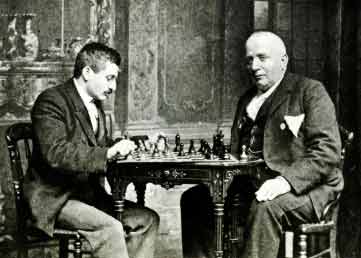 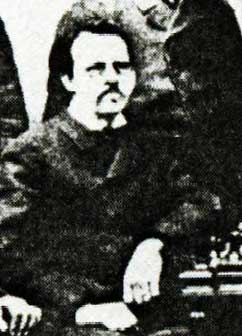 Dion M. Martinez
Dion M. Martinez
The "Men of the Athenaeum" was a loosely formed group under the auspices of
Charles Vezin. When he died in 1853, the Athenaeum gradually faded as
a chess force. The American Chess Congress revitalized chess in 1857
and in 1859 some of those same players formed the Philadelphia Chess Club.
Hardman Philips Montgomery, formerly of the Athenaeum group, was the club
champion. This club lasted off and on, it's last incarnation forming in
1875, hosting the International Chess Congress of 1876 . . .
[when "the newly organized Philadelphia Chess
Club held its first meeting in its splendidly furnished rooms, at No.10 West
Penn-square, on the evening of the 14th of December. There was a large
attendance of members, and the proceedings were characterized by much
enthusiasm. After the adoption of a constitution and the election of a board
of managers, there was an eloquent address from the President, J. II.
Bennett, Esq. City of London Magazine, 1875]
. . . until 1885 when many of the same members
regrouped and formed the Franklin Chess Club, one of the strongest chess
clubs in America.
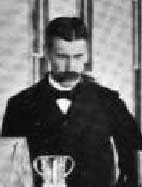 D.
M. Martinez, a wealthy Cuban who immigrated to America in 1875, was elected president of the newly
formed club. The board of the Philadelphia Chess Club in the final year
consisted of D. M. Martinez as President, Gustavus Reichhelm as
Vice-President, and Charles Newman as Secretary with Thompson, Michaelis,
Kaiser, Barclay and Del Puente making up the Executive Committee. Members of
the Franklin Club included Walter Penn Shipley, Emil Kemeny and William C. Wilson
-
even Harry Nelson Pillsbury had a membership there.. In 1893, Persifor
Frazer was it's president; W.C. Wilson was it's vice-president; the
treasurer was W.P. Shipley; Reichhelm was the secretary. D.
M. Martinez, a wealthy Cuban who immigrated to America in 1875, was elected president of the newly
formed club. The board of the Philadelphia Chess Club in the final year
consisted of D. M. Martinez as President, Gustavus Reichhelm as
Vice-President, and Charles Newman as Secretary with Thompson, Michaelis,
Kaiser, Barclay and Del Puente making up the Executive Committee. Members of
the Franklin Club included Walter Penn Shipley, Emil Kemeny and William C. Wilson
-
even Harry Nelson Pillsbury had a membership there.. In 1893, Persifor
Frazer was it's president; W.C. Wilson was it's vice-president; the
treasurer was W.P. Shipley; Reichhelm was the secretary.
In 1896, the Mercantile Library Chess Association was formed
in competition to the Franklin Club. While in just a short time it's
membership swelled to rival the Franklin Club, it had no dues and the
quality of chess was much lower. Eventually (1955) the two clubs merged into
what today is called the Franklin-Mercantile Chess Club.
Walter Penn Shipley
Chess in Philadelphia.
BY EMIL KEMENY.
Chess in Philadelphia is rapidly making headway. There are more
players than used to be but a few years ago, and, generally speaking, they
play better. The principal resort is the Franklin Chess Club. This
organization fairly represents the chess strength of the City of Brotherly
Love. The membership does not exceed one hundred, yet there is no difficulty
at all in selecting a pretty strong team of fifteen or twenty.
The Mercantile Library chess organization has about one hundred
members. Since the chess-room is open to all members of the library, we find
a much larger number indulging in play. Besides these two organizations,
within the last few years, there was formed the University of Pennsylvania
Chess Club, the Northwestern Chess Club, the Steinitz Chess Club, and pretty
nearly every branch of the Y. M. C. A. has its chess fraternity. -American
Chess Magazine, 1897
A Tragic End . . . .
The American Chess Magazine ran the following obituary in
1897:
William C. Wilson, a prominent member of the
Franklin Chess Club, bookseller and the proprietor of the Philadelphia
Circulating Library, was foully murdered in his store, at 1117 Walnut
Street, on the evening of August 16.
He was evidently killed by thieves, who carried out their purpose
of robbing the place after murdering him. At about 7.30 o'clock a
patrolman finding the gate at No. 1117 open and the door to Wilson's store
ajar, ascended the stairs through the second story, which was vacant, to
the third floor. Wilson's sleeping-room was on this floor, and in this
room Policeman Smith found everything in confusion. Closets, bureau
drawers and trunks had been broken open and their contents scattered on
the floor. The policeman went down-stairs to the store,
which is on the first floor, fronting on Walnut Street. On reaching the
foot of the stairs, Smith saw a blood-stained hammer lying on the floor.
Near the front of the store was a pool of blood, and leading from this was
a trail of blood around behind the show-cases.
There the officer discovered the body of Wilson with the skull
crushed in. The face was so bruised and covered with blood as to be nearly
unrecognizable. Wilson's trousers had been almost pulled off, and the
pockets had been turned inside out
There was a towel about Wilson's neck, with which his slayers had
evidently strangled him, to make their work more certain
Wilson was last seen alive at about 6 o'clock, when he left his
boarding-house to return to his place of business. He lived alone at the
Walnut Street store, and was accustomed to get his meals on South Tenth
Street. The men who killed him were evidently
familiar with his habits and apparently forced an entrance to the store
while he was out and lay in wait for him on his return. Mr.
Wilson was about 55 years of age. He hailed from New England, and at the
age of 16 was employed as a clerk in Prout's book
store, Worcester, Mass He showed remarkable talent for chess, especially
for playing blindfolded, and he conducted 3 games at one occasion, as told
in our last issue (p. 92). After having established himself in
Philadelphia, Mr. Wilson joined the Franklin
Chess Club. Whenever a star player gave a simultaneous exhibition at the
City of Brotherly Love, Mr. Wilson was sure to take a board against him,
and he took great pride in the fact that he seldom failed to win his game.
Among the scalps of great players
which he (figuratively speaking) wore around his belt were those of
Steinitz, Zukertort Tchigorin, Blackburne, Gunsberg, Weiss
and Bird. Before the Franklin Club moved to its present quarters in the
Hetz Building, it occupied a part of Mr. Wilson's
Circulating Library, then in Sansom Street. Their motive was undoubtedly
robbery Wilson was commonly supposed to keep a
large sum of money in the store.
RESOLVED, That in the death of our esteemed fellow-member, the late
lamented William С.
Wilson, we recognize that the Franklin Chess Club and the cause of chess
generally has lost a strong champion, a faithful
supporter, and an ardent enthusiast of the game The following resolutions
have been passed by the Franklin Chess Club :
RESOLVED, That we tender the relatives of the deceased our
respectful and earnest sympathy and that so far as possible we
will attend his obsequies as a last mark of respect.
The follow-up was even more bizarre. E. Winter [CN
#3891]
published the full account supplied by John Hilbert.
Here's a summation:
This account tells us that a man named William
Harris confessed being on of three robbers who murdered "the aged librarian
who was killed in his book store" during the robbery attempt. He claimed
they beat Wilson to death with a hatchet. Apparently the police didn't
believe the confession and continued searching for the murderers. William
Harris turned out to be John Tittemary. Next the police looked for a
man named "Big Bill" Mason in connection with the murder. Mason, who had
been arrested with two cohorts for a different robbery was seemingly never
chargred with the murder either.
Hilbert relays "Wilson’s Mysterious Murder, as various
periodicals called the death of the small chessplayer who had in his younger
days escaped Confederate prison, but who could not escape death by
bludgeoning in his own shop."
And though the story of Chess in Philadelphia in the 19th
century ended on a bitter note, the new century started with promise . .
.
from Chess by David Andrew Mitchell. 1917.
Lasker and Martinez
Among the interesting curios at the Franklin Chess Club is the score of
a chess game. There is, as a rule, nothing unusually striking about the
ordinary record of the moves of a game, but in this particular instance
the game was played between Doctor Lasker, the world's champion, and
Charles Martinez, probably the strongest player in Philadelphia in 1902,
at 20 moves an hour. These facts alone are sufficient to hold the
attention of the observer, but on glancing down the sheet the reader
finds, to his surprise, that the game was won by the brilliant
Philadelphian after 44 moves. Not the least interesting feature of this
attractive bit of chess history is that the entire score was kept and
signed by Doctor Lasker and given to A. K. Robinson, a strong
Philadelphia player, who presented it to the Franklin Club. The score of
the game follows:
|
|

